
31 minute read
Tulips at Morton Hall Anne Olivieri and
Anne Olivieri has always planted tulips at Morton Hall – provision was made for their inclusion in the borders here by designer Charles Chesshire in the original plans for the garden. But it wasn’t until 2019 that this Worcestershire garden opened for its fi rst Tulip Festival.
Unlikely as it sounds, the festival came about as a result of Anne’s frustration with the quality and consistency of the bulbs she had been buying. A true perfectionist, she plans her tulip displays with precision, carefully selecting colours and fl ower shapes, yet often experienced suppliers sending bulbs that fl owered in an unexpected colour, or cultivars she’d specifi ed being substituted. “I spend ages thinking about varieties and I’m obsessed with colours, so it really irritated me!” she announces. So she got in touch with the only supplier who had consistently sent her exactly what she’d asked for: Bloms Bulbs.
“Once our tulips have fi nished fl owering, they come out and are composted so it’s expensive for a one-off display,” says Anne. “I wrote Bloms a letter explaining that we take great pride in our tulip planting and needed to work with somebody absolutely reliable, hoping they might give us a good rate. In the end they came back and asked whether we would like to hold a
Above The South Garden enjoys a restrained colour palette of pastel pinks and purples. Below ‘Amazing Parrot’ – pink and orange in the best possible way. tulip festival with them. I thought that was quite an honour since there are only three or four other gardens in the UK where they do that – and it meant we would have access to fi rst-rate tulips.”
The garden’s regular open days already raise money for nearby Stratford-upon-Avon’s Royal Shakespeare Company and its Stitch in Time campaign (it was actually the theatre that drew Anne and her husband to this area when they bought the house in 2007). Anne decided that the RSC should benefi t from the money raised through ticket sales to the Tulip Festival too; in return, the RSC handle ticket sales for it through their website and help promote the festival.
“It’s a triple win,” Anne explains. “The RSC get the money from admissions; Bloms have a showcase here, and they stage a really nice cut fl ower exhibition in the orangery so they can talk to people and take orders; and we plant the tulips we want in our borders. Bloms don’t dictate at all which tulips we’re getting. They know I’m really particular!” So far, so good, but how do Anne and her head gardener Harry Green plan and plant the 5,000-strong bulb display under the pressure of knowing some 3,000 people will be turning up to see it? It’s apparently a combination of design, precision planning and clever cultivar choice.

Left A mixture of ‘Spring Green’, ‘Blue Diamond’ and ‘Sapporo’ tulips demonstrates the way Anne laces tulips through the border. Middle, from left Multiheaded tulip ‘Night Club’; ‘Flaming Spring Green’. Bottom Anne’s plan for just one of her borders, each symbol representing six tulip bulbs of one variety.

1Plan for tulips in your design Charles Chesshire, who designed the gardens at Morton Hall for Anne back in 2007, factored tulip displays into the borders he planned for her. “Charles is very keen on gardens having high impact,” says Anne. “In between the perennial planting in his beds he leaves gaps that can be full of tulips. We use only late-flowering tulips so it lights up with a bang in May, and then when they get taken out, they are replaced with annuals for lots more colour until the autumn.” It’s a highmaintenance and intensive style of gardening, not for the faint-hearted, but for impact and wow-factor it is hard to beat.

2Perfect the colour scheme The different gardens at Morton Hall are carefully colour themed. The formally laid-out South Garden concentrates on romantic, pastel shades, while the adjoining kitchen garden features warmer tones in borders that are based on the colours of the rising and setting sun. “I wanted the tulips to be in these colour schemes, so I’ve been trialling many, many different varieties over the years to see what fits the bill,” says Anne.

3Plan with military precision In order to keep track of all the tulip cultivars she was growing and trying, Anne developed a map to record all of the varieties and precisely where they are planted. “It’s a very defined planting plan that gives us the possibility of wandering around in May and seeing what is looking good or not so we can improve on the plan every year. Trying to remember which tulips are planted where is impossible,” she notes.
The plan is a work of art in itself – a diagram of the borders with each group of six bulbs represented by a coloured symbol that reflects the flower shape of the tulip. Anne prefers to distribute her tulips in


a lace-like pattern amid the permanent planting, rather than in more solid blocks of colour, so the resulting map more closely resembles a swatch of Liberty fabric than a traditional planting plan.
“We plant the tulips the way you plant a border: lower growing varieties on the outside, higher ones on the inside. I spend ages doing the map and thinking about the varieties every year, so I know I need a 60cm tall really perfect pink tulip, for example.” Choosing only from the late-flowering group of tulips ensures they all bloom at the same time, for one big hit of colour at Tulip Festival time.

Top In the Kitchen Garden, the colours are hotter: maroon tulip ‘Uncle Tom’ mixes with geums and heuchera, while ‘Flaming Spring Green’ adds contrast. Above right Lily-flowered tulip ‘Ballerina’. Above left ‘Lasting Love’ is a glossy deep crimson. Mixing their shapes – peony-flowered varieties with goblet shapes and pointier lily-flowered types for example – makes the scheme come alive.

4Prepare the beds before planting Work begins in autumn to get the borders ready for the big Tulip Planting Day, which is normally in mid-November. The week before, the borders are cleared of all spent annuals, weeds and leaves, and herbaceous plants are cut back. Any tree and shrub pruning that’s required is carried out and the soil lightly forked over in readiness for planting. To ensure a first-class display, Anne plants new bulbs every year. Once they’ve faded, the old tulips head to the compost heap where they are quickly turned into a soil-improving mulch that’s spread every autumn. “They help the next generation,” Anne explains.
5Foil tulip-hungry squirrels It’s a big job, but Anne has found the best way to deter squirrels from helping themselves to the tulip bulbs is to complete their planting in one day, so they are all safely in the ground at once. “I place every single one of the bulbs following the plan – every one of the symbols is six tulips of each kind. There are about 4,500 between the South Garden and the Kitchen Garden and another 600 in the Cutting Garden where we put the weird and wonderful tulips,” she says. Once the bulbs have gone in, the areas where they’ve been planted are
given a liberal dose of hot chilli powder. “We buy about ten kilos of it every year, and when it rains you have to re-do it, but it works. It deters the squirrels and it also works on voles, but it doesn’t interfere with the birds at all.” Anne’s noticed that squirrels appear to work in groups. “If one squirrel comes and takes a tulip, all of its mates will follow,” she says. “You just have to break that habit.”

6Pick the best cultivars There are some tulips, says Anne, that she has to grow every year. “I have to have ‘Mount Tacoma’ and I love black tulips, so we always have ‘Black Hero’, ‘Queen of Night’ or ‘Paul Scherer’. I also like the ‘Club’ series of multi-headed tulips.” With four to five flowers per stem, cream and pink ‘Candy Club’ and darker purple ‘Night Club’ reliably attract the attention of Tulip Festival visitors. “Importantly, we always break the colour scheme with a different colour that’s not in the mix to make it more interesting, and we usually use ‘Spring Green’ for that,” says Anne.
She finds lily-flowered types the most delicate in inclement weather, and peony-flowered ones surprisingly tough: after a hot spell over Easter 2019, that year’s Tulip Festival was preceded by a day of
Above Designer Charles Chesshire’s technique of creating pockets for seasonal planting among shrubs and perennials can be seen in this South Garden border. Top right Dark tulips are a must-have for Anne; this is ‘Café Noir’. Above right Tulip ‘Blue Diamond’ ages well for a longer period of interest. heavy rain and hail, and Anne was amazed by how many tulips pulled through. Others, such as ‘Blue Diamond’, age well. “They don’t fall apart; they change colour and ‘ripen’, in a way,” she muses.


7Find the right partners Tulips need the right plants around them to enhance their colours. “Camassias are a good choice because they add a colour that isn’t part of the tulip repertoire, but the acid lime-green of the perennials’ young growth also sets them off like a canvas, as does the foliage of the roses when it comes out, the clematis coming through, the new growth on the box balls in between – all the greens are there as a backdrop,” says Anne. On the walls, springflowering clematis such as C. alpina and C. montana provide a veil of flowers that doesn’t interfere with the tulip display, while a 200-year-old horse chestnut is covered in its gorgeous white candelabras. n
Morton Hall, Morton Hall Lane, Redditch B96 6SJ. The 2021 Tulip Festival should take place on 1-3 May, 10am-4pm. Tickets cost £10 and proceeds go to the RSC’s Stitch in Time campaign. Advance booking is recommended. Tel: +44 (0)1789 331111 or visit rsc.org.uk to book tickets and check for updates.
The Sky’s the Limit
With so many spring-interest plants and bulbs adding colour at a low level, a well-placed, spring-flowering clematis can help extend the display skywards
Clematis montana

This vigorous May-and-Juneflowering clematis is a boon for gardeners who’d love to cover expanses of fence, trellis, wall – or, indeed, eyesore – with flowers. It can even scramble its way up into sizeable trees: the white-flowered version, Clematis montana var. montana, looks absolutely beautiful climbing through the dark purple leaves of a copper beech tree. It’s easy to grow, requiring simply a sunny or partially shaded position in welldrained soil. Different cultivars offer variations on the species’ sugar-mouse-pink flowers. Look for ‘Broughton Star’, which has semi-double, deep pink flowers, or ‘Marjorie’, which has starry blooms in greenish-pink. No pruning is required, unless it needs tidying.
Clematis armandi

Another vigorous grower, this evergreen clematis produces masses of small, starry, white flowers from March to April and, as an added bonus, they have an almond-like scent. The long, thin and glossily dark-green leaves are handsome all year round, and when new growth develops in spring, the young leaves are an attractive shade of copperbronze, which adds to the interest. It’s happiest growing on a sunny, south or west-facing wall in welldrained soil, sheltered from any blasts of cold, drying wind. As with Clematis montana, pruning isn’t necessary, unless its growth needs curtailing or a tidying up. The cultivar ‘Apple Blossom’ has pink buds and flowers, which fade to white as they age.
Clematis ‘Sparky Pink’

If you’re looking for a springflowering clematis whose flowers have real impact, the Sparky series from Proven Winners’ range could be just the ticket. There are three lovely colours to choose from – ‘Sparky Pink’, ‘Sparky Blue’ and ‘Sparky Purple’ – all flowering in mid to late spring and often going on to produce more flushes of flowers in the summer. It’s easy to see why the series was named ‘Sparky’, with each flower resembling a pretty explosion of pointed petals. Reaching a maximum height of around 2.5m its manageable size makes it a superb choice for panels of trellis or obelisks in a border. Give it sun and good drainage and, because it’s a type of Atragene clematis it doesn’t need annual pruning.
Full Sail
With their big blooms arranged like the sails on a windmill, flowering cornus are striking trees, expert Guy Barter tells Louise Curley, leading the garden from spring into summer
PHOTOGRAPHS ANNAÏCK GUITTENY

Deep pink Cornus kousa ‘Miss Satomi’, one of the cultivars that comes highly recommended by Guy.
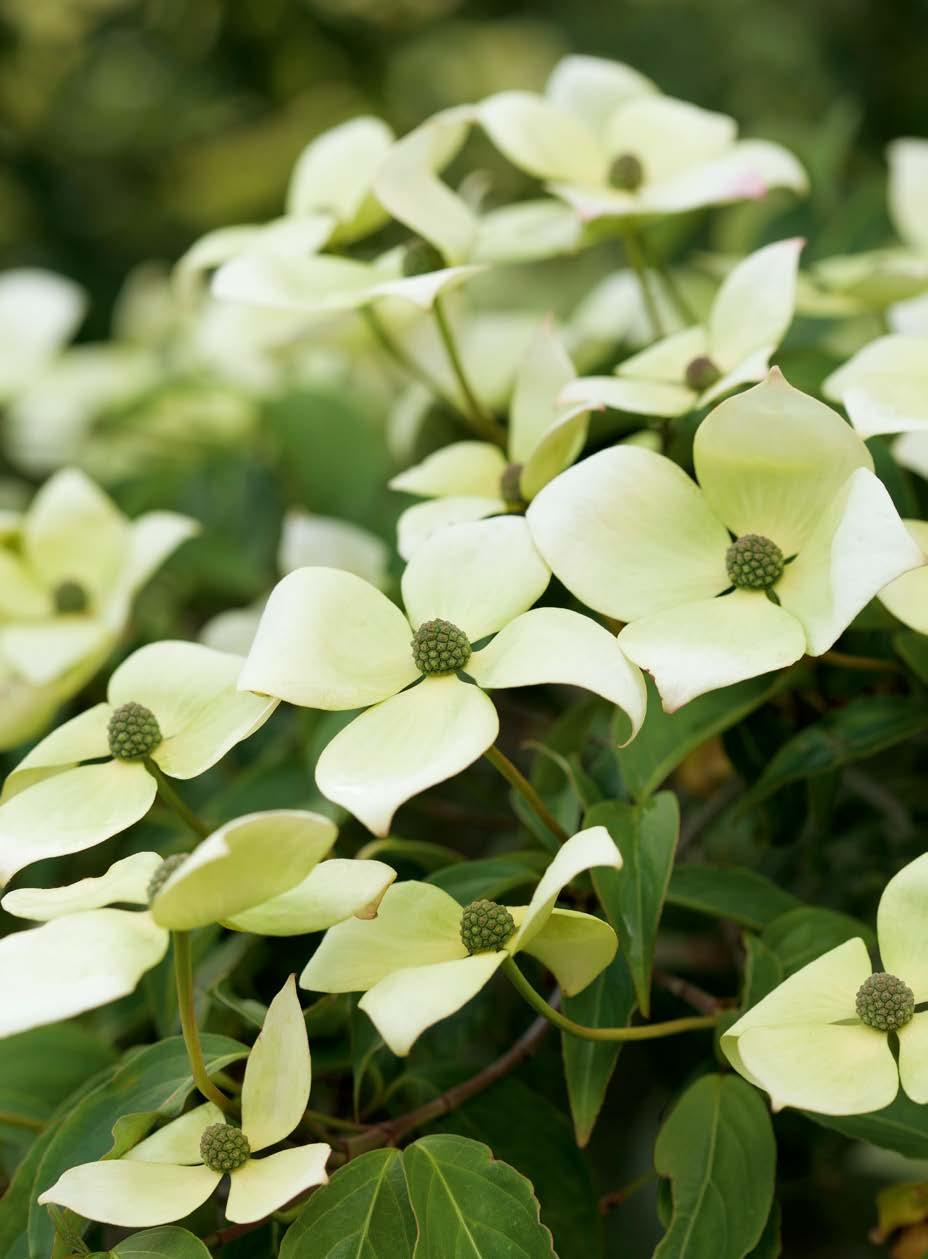
Cornus, usually known as dogwood, is a diverse group of plants. There are the fiery-stemmed shrubs such as Cornus alba ‘Sibirica’ lighting up winter gardens, low-growing species like C. canadensis hugging the ground at 10cm tall, and Cornus mas, the Cornelian cherry, a shrubby tree with masses of sulphur-yellow flowers in early spring. But it’s the flowering dogwoods that are the showstoppers of the genus, putting on a dazzling display that leads the garden into summer.
“Flowering dogwoods for the most part are not in the least bit demanding and fill a difficult gap between spring-flowering bulbs going over and the
Above Four bracts surround a cluster of flowers that turns into a decorative fruit. This is Cornus ‘Gloria Birkett’. roses and summer perennials taking off,” explains Guy Barter, chief horticulturalist at the RHS. “It’s one of the reasons why we planted a collection of them here at Wisley about five years ago.”
They form shrubs or small to medium-sized trees, ranging from 2.5 to 8m in height, depending on the species or cultivar. Most are deciduous, but there’s also the evergreen Cornus capitata, and generally the foliage is mid- to dark green in colour, although there are variegated forms. When planted in a slightly acid soil, they’ll produce a vibrant mix of purple, red and orange leaf colour in autumn, extending their season of interest. Some are upright and bushy, while others form a pleasing tiered structure as they mature and, over time, the bark develops attractive mottled tan and grey colouring.
But it’s the blooms, which look like a mass of butterflies perched on the branches, that make these such eye-catching plants. The flowerheads are actually made up of four or more bracts – modified leaves that act like petals – around a central cluster of tiny actual flowers. The bracts, which sit on top of the branches, are long-lasting and generally emerge lime green, fading to cream or white before taking on shades of pink; there are also several pink-flowered cultivars to choose from. From the centre of the bracts, strawberry-like fruit develop, which turn bright red in September. They look enticing and are edible. “I have tried them,” says Guy, “but I’m sorry to say they’re rather insipid.”
Flowering dogwoods include species from North America, with C. nuttallii being the earliest to bloom, in April, followed by C. florida, and those from East Asia, such as C. kousa and C. capitata, which flower in May and June. The Asian species and their cultivars are the easiest ones to grow in this country since they’re more suited to our climate. “Cornus kousa will grow in any reasonable garden soil in sun or partial shade,” says Guy. “I’ve noticed the ones at Wisley prefer a bit of shelter and they’ll happily grow in acid to alkaline soil. C. florida is said to be fussier because it prefers a more acid soil, but I suspect, as is often the case, with these things, that they’ll put up with an alkaline soil as long as it’s

Above left Evergreen Cornus capitata. Above right Cornus ‘Celestial’ from the Stellar Series. Below right Cornus kousa ‘Trinity Star’. Below left Cornus kousa ‘Miss Satomi’.

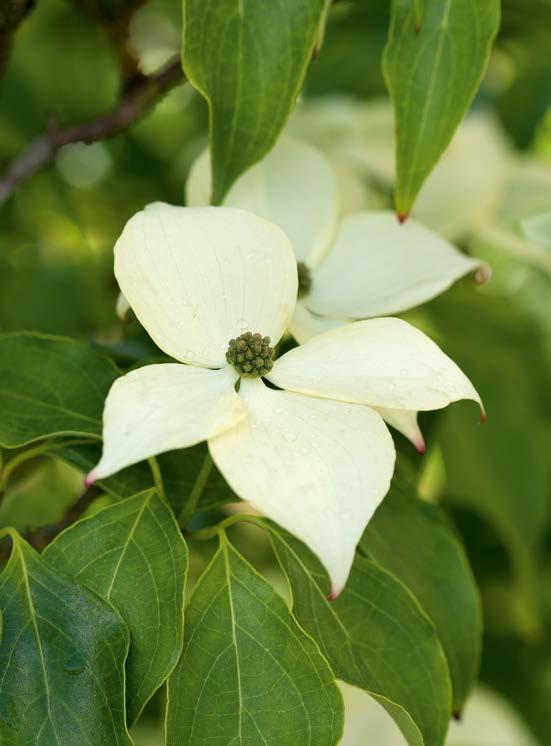



moist.” The National Top Cornus kousa var. Collection of Flowering chinensis ‘Wisley Queen’. Dogwoods is held at Below right Cornus kousa ‘Greensleeves’. Newby Hall in North Below left Spectacular Yorkshire where there’s Cornus ‘Venus’. a spectacular collection of over 100 specimens, and at Highdown Gardens in Sussex there are flowering dogwoods happily growing on alkaline soil, which shows these are very adaptable plants.
“We don’t grow many of the North American types at Wisley, although we do have C. nuttallii ‘Eddie’s White Wonder’, which has an AGM, in an area of moist woodland – and it does well. It’s no bigger than a large shrub, so it’s a good choice if you’re looking for something compact. As part of the main collection, we’ve also planted a group of the Rutgers cultivars, which are spectacular,” adds Guy.
The Rutgers hybrids, such as C. x rutgersensis ‘Stellar Pink’ and the white-flowered ‘Aurora’, are the result of a breeding programme set up at Rutgers University in New Jersey, United States, after native dogwoods came under attack in the 1970s from the fungal disease anthracnose and the dogwood borer beetle. By crossing C. florida with C. kousa they produced the ‘Stellar’ series of cultivars that are highly resistant to the dogwood borer and have improved resistance to both powdery mildew and anthracnose. They’re also hardier, so are better suited to the British climate. The same breeders also crossed C. kousa with C. nuttallii to create ‘Venus’.
“We have ‘Venus’ at Wisley and words fail me! It’s absolutely incredible. You can’t see the tree for blooms. Some people say it’s over the top, but I think it’s absolutely glorious,” says Guy. ‘Miss Satomi’ is another of his recommendations. “It isn’t as freeflowering as ‘Venus’, but it’s still very floriferous and covered in deep pink flowers. It’s smaller than other cultivars so it makes a good choice for small gardens and container growing. It’s bred in Japan and our specimen at Wisley attracts so many queries that we’ve had to put up a notice to tell visitors a bit more about the plant.” Guy also recommends ‘Greensleeves’, which has huge white bracts, some of the biggest you’ll come across, which look as if handkerchiefs have blown into the tree. They also tend to retain a greenish tint to their white blooms.
For gardens in the north, Cornus kousa ‘Milky Way’ is a good option, since it will flower profusely and readily form fruit, even in cooler summers. And for something a bit different there’s ‘Mandarin Jewel’ with its orange-coloured fruit, or ‘Summer Fun’, with variegated foliage that turns striking shades of pink in autumn.
These versatile plants look equally as good in traditional planting schemes as they do in something more contemporary. Their elegant habit and delicate blooms make them an ideal specimen plant

GROWING ADVICE Caring for Cornus

Guy Barter explains how best to look after these high-performing, flowering trees
Flowering cornus need little
pruning beyond the removal of lower branches as the tree matures to create a clear trunk. The shape of those that develop the tiered structure can be spoilt by pruning, but the more upright, bushy types can be pruned if they’re outgrowing their space; do this in winter when the plant is dormant.
They’re generally free of pests and disease and I don’t know of any enquiries from RHS members about anthracnose; it’s not a problem we’ve encountered here at Wisley.
Clear weeds from under trees
especially when they’re young. Mulching around the plant with compost is also beneficial.
Feed with a general-purpose
fertiliser in February if your soil is poor – otherwise, it isn’t really necessary.
If you have heavy, poorlydrained clay soil it might be a good idea to plant your tree on a slight mound to improve the drainage.
If you’re planting cornus in a spot where there has been honey fungus, wait for six months after you’ve removed the infected plant. This is enough time for the fungus to die off and it shouldn’t affect your new tree.

Top left Cornus kousa for a Japanese-style ‘Wieting’s Select’. garden, and Guy also Top right Cornus ‘Mandarin Jewel’. recommends them Above Cornus kousa as a good tree for a ‘Summer Fun’, with front garden. Some variegated foliage. develop a spreading canopy as they mature, so check the growth habit before you buy and give them plenty of space to develop. For a small garden, seek out compact cultivars like ‘Nicole’ and ‘Satomi Compact’, which will happily grow in large containers as long as the soil is kept moist.
Underplant your cornus with ferns and spring bulbs or use hardy geraniums just as they do at Wisley. “The main collection at Wisley is planted in a lovely lawn area next to the rose garden,” Guy explains. “It’s underplanted with camassias that flower in early May, creating a sea of blue, and the cornus follow on from the camassias. We’ve also got a selection of cornus growing in a woodland area where they’re combined with hydrangeas to provide continuity of colour.” n

Highgrove House shares an intimate relationship with its wildflower meadow, which is awash with the russet tones of common sorrel (Rumex acetosa) and ox-eye daisies (Leucanthemum vulgare).

lowers for the Queen f
Marking the 60th anniversary of The Queen’s enthronement, Coronation Meadows, established by Prince Charles with conservation charity Plantlife, celebrate Britain’s floral diversity. Their beauty is revealed in this exclusive extract from Wildflowers for the Queen
PHOTOGRAPHS HUGO RITTSON THOMAS
M“ y own meadows at Highgrove are home to over seventy different wildflowers and grasses – from the humble ox-eye daisy, cock’s-foot or bird’s-foot trefoil, through to the glamour of the seven species of orchids that have now become established. A walk through a wildflower meadow at the height of its midsummer glory is at once intoxicating and restorative; bringing both joy and peace into our busy lives. The tragedy is that this is an increasingly rare experience. There is no doubting the scale of the appalling loss of meadows from the British countryside, with over 97% having vanished since the 1930s. In an attempt to stem this terrible loss, I asked Plantlife to lead the Coronation Meadows partnership with the Royal Society of Wildlife Trusts and the Rare Breeds Survival Trust, all of which I am Patron. To step into a wildflower meadow is to step out of time. Whether a cherished area of one’s garden or part of the wider farmed landscape, meadows hold a special place in our hearts.” HRH The Prince of Wales. Taken from the foreword to Wildflowers for the Queen.


Left Common spotted orchids (Dactylorhiza fuchsii) flower in abundance. Bee orchids (Ophrys apifera) also bloom at Highgrove. Below Lupins and other ornamentals provide additional seasonal colour to the meadow.
HIGHGROVE
Gloucestershire
HRH The Prince of Wales Created over thirty years ago, the wildflower meadow at Highgrove has a wonderfully secluded and intimate atmosphere. Tall trees provide a back-drop and the meadow wraps itself around the more formal walled gardens of Highgrove House; the connection between meadow and formal garden is enhanced by cut-outs in the hedges, while closely mown paths carry you through the swathes of wildflowers.
The meadow was the brainchild of HRH The Prince of Wales and Dame Miriam Rothschild, who sowed a mix of over one hundred species typical of Gloucestershire to replicate the old meadows that had been lost over time. Since then, seed-rich green hay from Clattinger Farm, the flag-ship Coronation Meadow for Wiltshire, has been strewn on the meadow each year.
Today, the meadow is a tightly woven tapestry of wildflowers; seventy different species were found by botanists on a single visit. Early in the year cowslips (Primula veris), cuckooflower (Cardamine pratensis), sometimes called lady’s smock, and pignut (Conopodium majus) colour the sward, but by late spring the meadow is in full throttle, a riot of meadow buttercup (Ranunculus acris), common sorrel (Rumex acetosa) and yellow rattle (Rhinanthus minor). Ox-eye daisy (Leucanthemum vulgare) and common knapweed (Centaurea nigra) abound and here and there are other jewels: great burnet (Sanguisorba officinalis), betony (Betonica officinalis), field scabious (Knautia arvensis) and meadow crane’s-bill (Geranium pratense).
But it’s the common spotted orchids (Dactylorhiza fuchsii) that steal the show. Relatively recent arrivals, they’ve found it to their liking and have romped through the meadow, a host of nearly six thousand lilac maidens in the grass. They aren’t alone. Southern marsh orchids (Dactylorhiza praetermissa) also grow here, hybridising with common spotted orchids when they meet, and in several spots pyramidal (Anacamptis pyramidalis), bee (Ophrys apifera) and green-winged (Anacamptis morio) orchids sparkle in the sun.
The impressive and familiar outline of Highclere Castle is softened by meadow crane’s-bill (Geranium pratense) and a wealth of other wildflowers.

Mist shrouds the valley and, as Highclere’s meadows approach the end of their season, field scabious (Knautia arvensis) puts on a final flourish before the hay is cut. HIGHCLERE CASTLE
Wiltshire
Earl of Carnarvon My wife and I began to create the wildflower meadow here at Highclere Castle over ten years ago. We prepared the ground by harrowing for two years to break up the existing grass so that the wildflower seeds could establish themselves with less competition. The mixes of seeds chosen were geared towards traditional Hampshire chalk grassland species and, over the years, it has developed, changing in colour and deepening in variety. In mid-October we harvest the seeds, which are packaged for sale in our gift shop, before we cut and remove the hay to maintain the low fertility of the area, which is vital for the wildflowers.
We have a diverse collection of around forty wildflowers and grasses including the rare bee orchid (Ophrys apifera), field scabious (Knautia arvensis), bird’s-foot trefoil (Lotus corniculatus), harebell (Campanula rotundifolia), vetch (Vicia sp.), eyebright (Euphrasia sp.) and milkwort (Polygala sp.). Many of them have traditional uses: Lady’s bedstraw (Galium verum) repels fleas in mattresses as well as giving a yellow dye used to colour cheese such as Double Gloucester, while common vetch
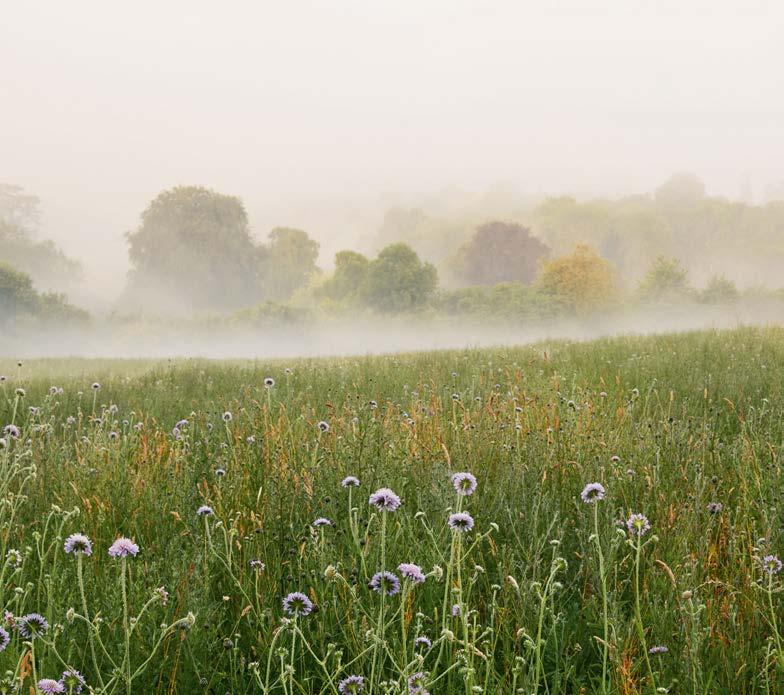

(Vicia sativa), for example, has been used for fattening cattle or perhaps as part of an early diet for people. We mow a broad, winding path running through the meadow diagonally for visitors to enjoy. In the season it is full of colour and is a haven for insects: this year we had so many bees in high summer there was a continual, audible hum from the field! A true testament to the wildflower meadow’s success.

Top Greater knapweed (Centaurea scabiosa) adores soil that is rich in chalk or limestone and produces its pompon flowers well into autumn. Above The long, pointed seedheads of Geranium pratense give this plant its common name of meadow crane’s-bill. The formal gardens and parkland at Blenheim Palace cover a landscape of 975 hectares and include spectacular floodplain meadows and flower-rich pastures.

BLENHEIM PALACE
Oxfordshire
Duke of Marlborough Blenheim Palace is over 300 years old and a UNESCO World Heritage Site, making it a place of great historical importance. We see heritage as our legacy from the past, what we live with today and what we pass on to future generations. At Blenheim we are fully committed to protecting not just the Palace and buildings but also the Estate, which is home to an abundance of life including the wildflowers that have taken root in our meadows on the Estate. We are proud the Estate is managed under one of the most diverse Environmental Stewardship Agreements in the country.
The wildflowers that once comprised ‘the colourful mantle of our green and pleasant land’ were greatly sacrificed during the Second World War to support the war effort. The protection and continued life of over fifty different species found here is vitally important to us: they are our life support and the meadows have become home to bees, butterflies and various other wildlife. The

park is home to hidden treasures of all kinds and it is a great source of inspiration, enjoyed for its beauty and peace.
Winston Churchill, who was born, baptised and got engaged at Blenheim, spent his young years exploring the park and gardens. When he left the trenches of the First World War in 1916 the first thing he wanted to do was come to Blenheim Palace to paint and again be inspired. We hope we have succeeded in restoring some of that magic. n

Wildflowers for The Queen: A Visual Celebration of Britain’s Coronation Meadows by Hugo Rittson Thomas. In partnership with Plantlife and with a foreword by their patron HRH The Prince of Wales. Profits from sales go to Plantlife (Wildflower Press, £50).
Below Rare meadow clary (Salvia pratensis) steals the botanical show at Blenheim, one of just a handful of sites for this plant in Britain.
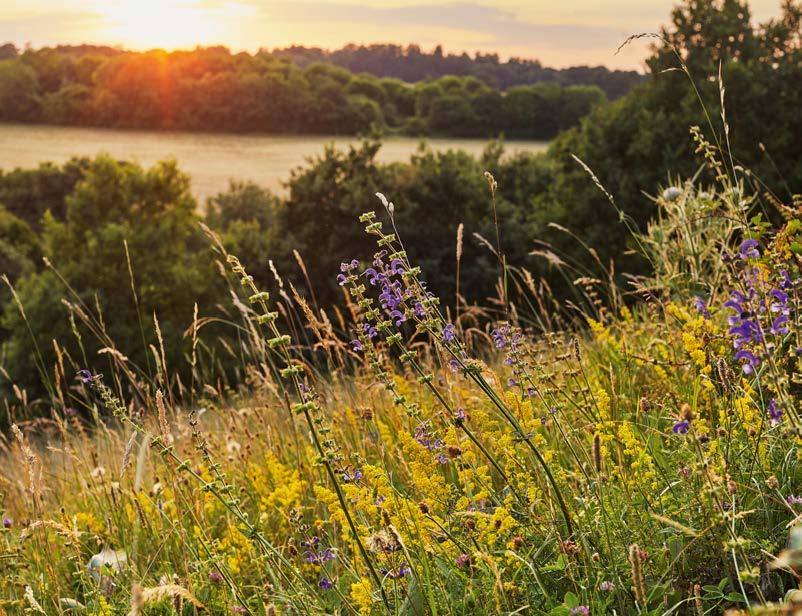
International Garden Photographer of the Year

In association with The English Garden, this annual competition seeks the best images of plants, gardens and landscapes from around the world
The winner of International Garden Photographer of the Year is Robin Williams of Melbourne, Australia, for his image of a white lotus flowerhead, which won the Beauty of Plants category of the competition. Robin’s image of the Nelumbo nucifera bloom was taken in the Blue Lotus Water Gardens of Yarra Junction, Victoria. Lotus are aquatic perennials that have the ability to use thermo-regulation: self-heating their flowers to aid fertilisation by bees, flies and beetles. Robin is an internationally recognised photographer whose career, particularly in the fields of medical photography and photographic education, spans four decades. He moved to Australia from the UK in 1992.
“Robin has used macro photography to immortalise the culturally iconic and ancient lotus species. The composition, intention and novelty invite us in with a delicious allure and promise of sensory satisfaction. Like the countless tiny creatures that are drawn onto its warm golden facade, we cannot help but stop, stare and absorb the sense of potential delight, as if caught outside the window of the world’s finest patisserie,” says IGPOTY’s managing director Tyrone McGlinchey.
“I am absolutely thrilled to be named ‘International Garden Photographer of the Year 2020’ – I am always inspired by the beautiful work submitted by photographers all over the world and humbled to think that my work can stand shoulder-to-shoulder with theirs,” says Robin. “We all celebrate the beauty of the natural world and in doing so, hope to protect it.”
Ten winning images from IGPOTY’s 14th Competition are featured here, but all the winning images will be available to view on the IGPOTY website from 6 February. The exhibition is then set to tour the country, on display at venues such as UNESCO World Heritage Site Blenheim Palace and Herrenhausen Gardens in Germany, but this will depend on local and national restrictions. Please visit igpoty.com where you can also find out how to enter Competition 15.

WINNER The Beauty of Plants Robin Williams
Creation
Victoria, Australia
“I captured this macro shot of the golden reproductive parts of a Nelumbo nucifera (white lotus) flowerhead, which was ready for pollination. The sacred lotus is a rhizomatous aquatic perennial and is a ‘living fossil’ dating to pre-history, having been domesticated in Asia about 7,000 years ago.”
Beautiful Gardens Nigel McCall
Indian Summer Morning
Aberglasney Gardens, Carmarthenshire, Wales, UK

“The Upper Walled Garden is an inspiring place to photograph at virtually any time of year. It was now late October and the cool and sometimes frosty nights were being followed by warm, bright and calm days. Mist filled the valley and the morning sun began to highlight the scene; the conditions were perfect to photograph an ‘Indian summer’ morning.”
Abstract Views Claire Ogden
Magical Trees
Roseland Peninsula, Cornwall, England, UK

“I was looking for colour but few leaves remained on this hillside of trees in late autumn. Using software, I inverted and then altered the colours further to create this magical, abstract treescape.”

Wildlife in the Garden Petar Sabol
Survivor
Goričan, Međimurje County, Croatia
“Beauty can be found in the imperfect, damaged wings of this male dragonfly – Sympetrum striolatum (common darter). I discovered this specimen close to the pond in my garden. It was morning when beads of dew were still to be seen and I waited for the perfect alignment to complete the composition.”
Greening the City Richard Bloom
Valencia Parque Central
Valencia, Spain
“Valencia Parque Central was implemented by lead landscape designers Gustafson Porter + Bowman. Phase 1 was completed in 2019, following the relocation of high-speed trains below ground. It is one of the city’s most significant redevelopments at a total site cost of €73 million.”

Wildflower Landscapes Simon Lea
Poppy Coven
Coven, West Midlands, England, UK
“I captured this photo at a then secret location in the West Midlands at sunrise – the town nearest to the field is called Coven. As with all sunrise photos, you have to get up extremely early, especially when you are travelling 30 minutes from your home to be there. The reward is a photo that is unique to you, because no one else is there capturing the same magical moment as the sun hits the first poppies.”
Trees, Woods & Forests Gianluca Gianferrari
Flooding Birches
Guastalla, Emilia-Romagna, Italy

“Sometimes nature reminds us of her power, but even then gives us beauty. The Po River flooded and created a striking scene, ready to photograph, of these beautiful Betula pendula (silver birch) trees.”
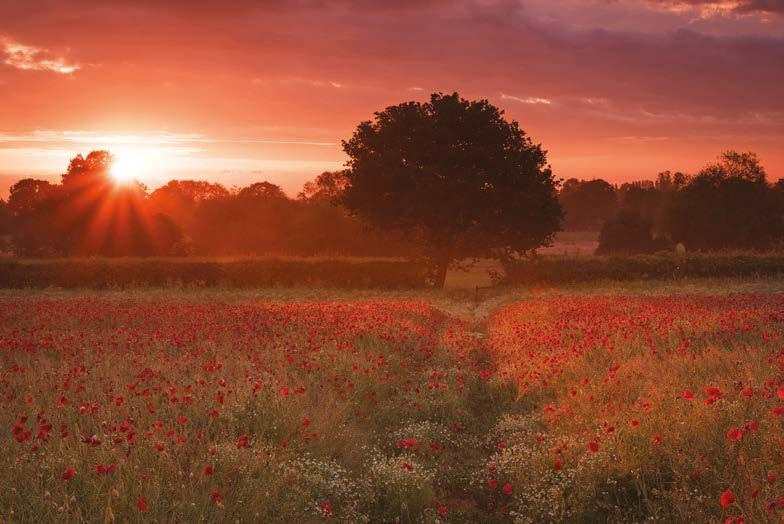
Plants & Planet Jonathan Barran
Tolaga Bay
Tolaga Bay, North Island, New Zealand
“A series of intense storms due to climate change have brought down thousands of tons of wood from forestry plantations in the flooded rivers behind Tolaga Bay. The rivers have spilled their cargo of wood onto the beach, destroying the sand dunes and plants in the wake.”

Breathing Spaces Luka Esenko
Land of the Waterfalls
Plitvice Lakes National Park, Plitvička Jezera, Croatia

“I visited the UNESCO World Heritage Site of Plitvice to capture the stunning winter scenery and woodlands with one of the many impressive waterfalls in the park.”
The Royal Photographic Society Gold Medal –Portfolios David Townshend
Hosta Patterns
Northamptonshire, England, UK
“There are always images waiting to be created, even early on a wet June morning. Pots of hosta, heuchera and libertia on my patio, each with their own distinctive leaf shape, texture and colour, were transformed as rain droplets collected on them with the gloom accentuating their colour. Moving my camera during the sequence of exposures, I captured their transient beauty as unique patterns that are at the same time bold and intricate.”


Hannah McVicar working with her transportable screenprinting kit at her family’s business, Jekka’s Herb Farm in Bristol.
An Eye for Beauty

The detail and life cycles of plants, in all their various forms, inspires Hannah McVicar’s exquisitely detailed botanical screenprints and illustrations, produced from her Bristol studio







